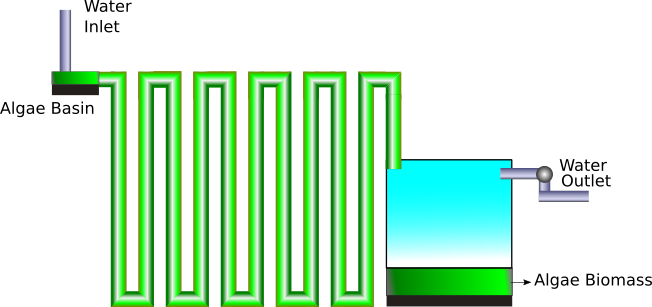Cultivating and Harvesting Spirulina
WIPSpirulina needs water sunlight, nutrients and carbon dioxide to grow and form colonies. It can be in small tanks or containers placed on a rooftop or in large cultivation tanks in a farm. Spirulina grows naturally in sea water, fresh water, and grey water as well.
Requirements
The following are required to cultivate and harvest spirulina.
- Spirulina culture
- Container
- Water
- Nutrients
Spirulina Culture
Spirulina can be carefully extracted from rocks, walls or stones or are available commercially from botanical or marine stores.
Container
Plastic containers or aquariums can be used to cultivate algae. Spirulina needs sunlight so a transparent container is a good way to increase exposure to sunlight. Commercially spirulina is also grown in transparent vertical pipes or horizontal cultivation trays. The following illustration shows a schematic diagram that can be placed vertically or horizontally for large-scale cultivation.
Figure 1 - Schematic diagram of an algae farm
If cultivating in open tanks or trays, a greenhouse protection is needed to protect spirulina from rains, dust and insects.
Water
Spirulina grows in Sea water and fresh. When cultivating on land-farms, chlorine-free water is the most effective medium to grow spirulina.
Note: Spirulina can grow in grey water as well. Grey water is the waste water from kitchens, showers and laundry machines. Spirulina cultivated in grey water is will need further steps of purification before consuming. It is not recommended unless cultivated in areas where there there is a shortage of water.
Nutrients
Spirulina culture nutrients are commercially available at local agricultural or botanical stores or can be ordered online. Ensure that the nutrients contain the following compounds:
- Sodium bicarbonate
- Magnesium sulfate
- Potassium nitrate
- Citric acid
- Salt
- Urea
- Calcium chloride
- Iron sulfate
- Ammonium sulfate
Cultivating Spirulina
Spirulina can be cultivated with as much as a test tube of fresh live algae. Place the spirulina in the algae basin and add nutrients at regular intervals of time. Within 5 to 6 weeks, in the right protected conditions, spirulina grows to form an algae biomass.
Harvesting Spirulina
After 5 to 6 weeks, the spirulina biomass is removed from the tray and filtered using a soft cloth. Filtration removes the water and spirulina is now available as a dark-green, slimy, sticky semi-fluid matter.
Fresh Harvest
At this stage, spirulina is at its nutritional best. It is freshly harvested and packed with nutrients. It is also odorless and tasteless, and can be mixed with other foods and beverages.
Storing Spirulina
Spirulina can also be stored in closed containers and refrigerated. It has a shelf life of 2 weeks. It can also be dried and processed into powders, pills and tablets for long term use.

